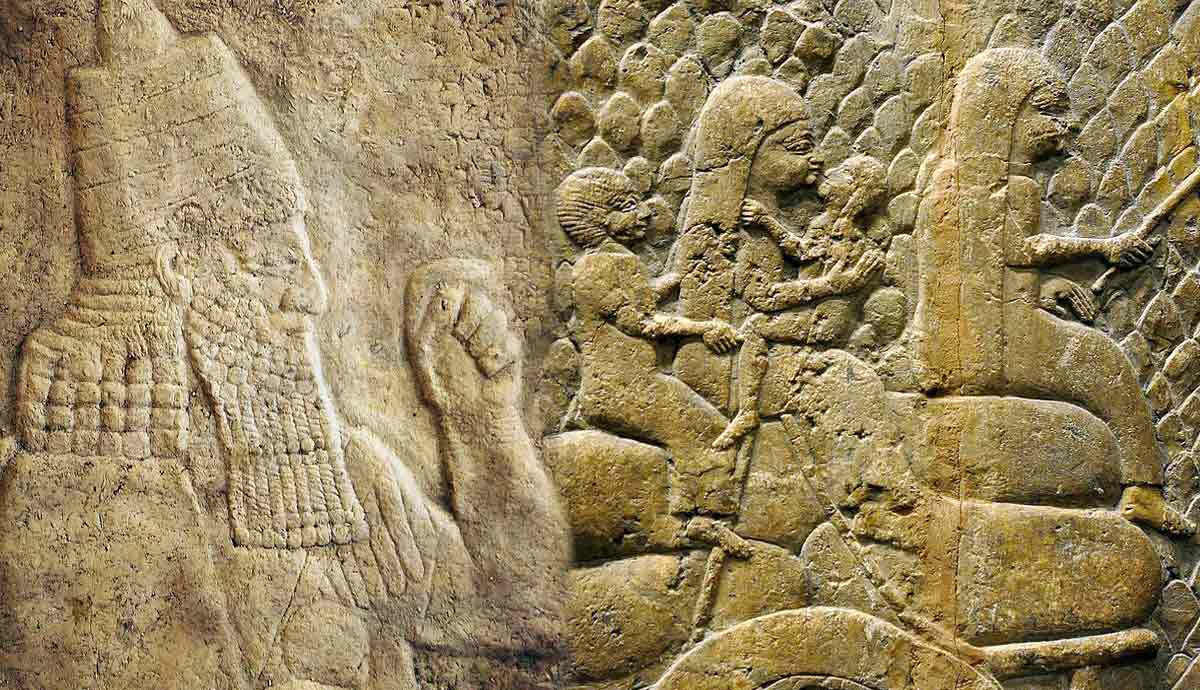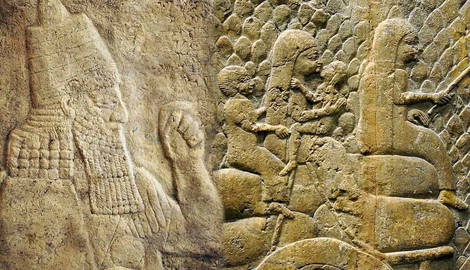
Sennacherib was an Assyrian king who reigned from 705 to 681 BCE. He was known for consolidating and expanding the Neo-Assyrian Empire. In the biblical narrative, he invaded Judah during the reign of King Hezekiah in 701 BCE, capturing many fortified cities and eventually laying siege to Jerusalem. The siege ends with one of the most fascinating divine interventions in the Old Testament. According to the Bible, the angel of the Lord struck down 185,000 soldiers of the Assyrian army in one night. Sennacherib had to return to Nineveh to recover from the devastating loss.
Life and Reign of Sennacherib

Sennacherib was born to the King of Assyria, Sargon II. Sargon expanded the Assyrian Empire of his day, and Sennacherib continued that legacy when he became king upon Sargon II’s death in battle in 705 BCE. He immediately faced a rebellion from nations his father had subdued, such as Babylon and several nations from the Levant.
Babylon was a strategically important city to control due to its cultural and economic significance. The Esagila, a temple in honor of Marduk, the primary god of the Babylonians, was located in the city, and Babylon was an important trade hub located on vital trade routes.
Merodach-Baladan (Marduk-apla-iddina II) led the rebellion in Babylon. Initially a local chieftain, he took the Babylonian throne. He allied with Elam and stirred the revolt against Assyrian control. At the Battle of Cutha and Kish in 703 BCE, Sennacherib defeated a Babylonian-Elamite coalition that saw Merodach-Baladan flee into hiding. Sennacherib installed Bel-ibni in his place and plundered the city of Babylon’s wealth.
About a decade later, Merodach-Baladan reappeared and took the city, again with the help of Elam. Sennacherib replied with a two-pronged response. On the one hand, he launched naval attacks against Elam’s coastal strongholds to interrupt their support, and on the other, he engaged with Chaldean rebels in the marchlands. This was a grueling and slow process that lasted for years. Sennacherib grew frustrated at the protracted campaign and decided to attack Babylon itself.
After a long siege, Sennacherib’s forces breached the defenses of Babylon and desecrated the sacred sites in the city, such as Esagila, the temple of Marduk. He also diverted the water of the Euphrates to flood the city. The survivors were enslaved or relocated to depopulate Babylon further and break down its social structure.
Sennacherib’s actions were frowned upon even by the Assyrians, who shared the Mesopotamian heritage reflected in Babylon and revered the city as a cultural and religious capital. The desecration of sacred sites in Babylon alienated many Assyrians who feared divine disfavor and fueled anti-Assyrian sentiments among many other nations. Many sources portray Sennacherib as a tyrant.
Sennacherib’s Invasion of the Levant

Like in Babylon, a rebellion broke out in the Levant when Sargon II died, and the Levantine nations sought to shed the Assyrian yoke. In 701 BCE, Sennacherib launched a campaign into the Levant to subdue several uprisings and revolts. Among these nations were Tyre, Sidon, and Judah, who formed a coalition to ward off the Assyrians.
Sennacherib quickly subdued many Phoenician cities, like Sidon, and towns on the north-western coast of the Levant. As they conquered, the Assyrians installed rulers loyal to them. The campaign moved south to confront armies of Philistine cities like Ekron. Since the Levant served as a buffer zone between Egypt and Assyria, it is unsurprising that Egypt entered the conflict. Sennacherib won the Battle of Eltekeh by defeating a combined rebel and Egyptian force. The Assyrians restored King Padi to the throne, who was deposed when rebel factions took the city. Other cities in Philistia, like Ashkelon and Gaza, also fell to Sennacherib and secured that region for the Assyrians.

Judah seems to have been the heart of the rebellion. Here, many fortified cities fell to the Assyrians, with Lachish being the most notable. It was the second largest city in Judah, which is why it features prominently in reliefs in Nineveh. These reliefs show siege ramps, battering rams, and the mass deportations that followed. Excavations at Tel Lachish confirmed the onslaught when archaeologists uncovered ramparts, arrowheads, and a destruction layer consistent with a date of 701 BCE.
Sennacherib advanced his armies to Jerusalem and laid siege to the city, demanding that King Hezekiah surrender. The Taylor Prism describes Hezekiah as “shut up like a bird in a cage” as Assyrian forces encircled the city and cut off supplies. To prevent death and destruction, Hezekiah paid a large tribute of 30 talents of gold and 300 talents of silver (2 Kings 18:14). Assyrian records claim the tribute was 800 talents of silver. Threats against the city continued despite the tribute.

According to the biblical narrative, the angel of the Lord killed 185,000 Assyrian soldiers gathered around Jerusalem. The Assyrian record is silent, not confirming or denying the capture of Jerusalem. If the Assyrians conquered Jerusalem, it would have been recorded in the Assyrian records as an achievement of Sennacherib. Like many kingdoms in antiquity, records often omit embarrassing events or losses. It suggests that the Assyrian forces withdrew from Jerusalem and returned to Nineveh.
The Assyrian campaign into the Levant was successful. It brought many cities in the Levant back under Assyrian control and took many riches and people to Assyria as loot. Assyrian forces did not take Jerusalem, but Judah became a vassal state.
The Bible portrays the survival of Jerusalem as a humbling experience for the aggressor, Sennacherib. The narrative attributes the event to divine intervention, and it shaped Judeo-Christian theology many years later.
Egyptian involvement in some of the clashes foreshadowed the Egyptian-Assyrian conflict at a later date. The Bible mentions that Josiah, one of the greatest reformer-kings of Judah, died at the hands of Pharaoh Necho when he traversed through Judea to do battle with Assyrian forces.
Archaeological Evidence for Sennacherib

The Bavian Inscription, a record by Sennacherib, recorded the destruction of Babylon and presented it as divine retribution for their defiance. In addition, Assyrian sources, including the Taylor Prism and palace reliefs at Nineveh, which depict his southern conquests, testify to Sennacherib’s campaigns. Layers of destruction in Babylon dated to around 689 BCE align with events described in some records.
The Taylor Prism is a six-sided clay record of Sennacherib’s first eight military campaigns. The artifact includes accounts of Sennacherib’s invasion of Judah. It details the conquest of several cities and the siege of Jerusalem. Like some Egyptian records, it omits embarrassing events and losses that would cast the Assyrians in a bad light.
Many tablet inscriptions and cylinders record the Assyrian invasions of Elam, Chaldea, and the Levant consistent with Sennacherib’s reign. These records often reflect imperial propaganda. Many other palace reliefs and artworks from the time show sieges, battles, and royal imagery that boast of the extent and success of Sennacherib’s rule.
Excavations in Nineveh show the grandeur of the “palace without rival,” city walls and gates, irrigation systems, and other features that reflect the upgrades and transformation Sennacherib’s construction efforts contributed to the city infrastructure.
Archaeological evidence attests to the military campaigns Sennacherib launched on Lachish, Jerusalem, Babylon, and other cities in southern Mesopotamia. The Esarhaddon’s Records confirm that Sennacherib was assassinated in 681 BCE by one or more of his sons. Some records from Nineveh contain evidence of succession disputes among the sons of Sennacherib, supporting Esarhaddon’s version of events.
Sennacherib’s Legacy

Sennacherib’s legacy is one of military power and imperial expansion. Under his rule, military advancements in equipment and new tactics were implemented. Though he had great successes, he had losses as well, as is evidenced by the failed siege of Jerusalem.
Under Sennacherib, Nineveh’s infrastructure was upgraded and increased. Nineveh became an imperial hub with examples of contemporary innovation in engineering and urban planning, with art being used as state propaganda.
One consequence of Sennacherib’s campaigns was the development of a robust administrative system. The system saw money extracted from subdued nations in the form of taxes to bolster the Assyrian economy. It also managed relations with vassals, and deported people to reshape demographics and prevent rebellion by changing societal structures and controlling labor. The coercive nature of these actions left a negative impression of his rule that spurred unrest among many subservient nations.
The desecration of the temple of Marduk was offensive in the minds of most Mesopotamians. Fear of divine retribution spread among the Assyrians. This act of removing the statue of Marduk from Esagila had a negative influence on how Mesopotamians viewed Sennacherib’s reign.
Though Assyrian records present him as a divinely ordained heroic conqueror, builder, and ruler, later Babylonian records reflect on Sennacherib as a villain and blasphemous oppressor. Sennacherib’s legacy depends on the perspective of the critic who considers his life and rule. What is not subject to perspective is that he had a significant impact on shaping the Mesopotamian world and the Levant during the late 8th and early 7th century BCE.










